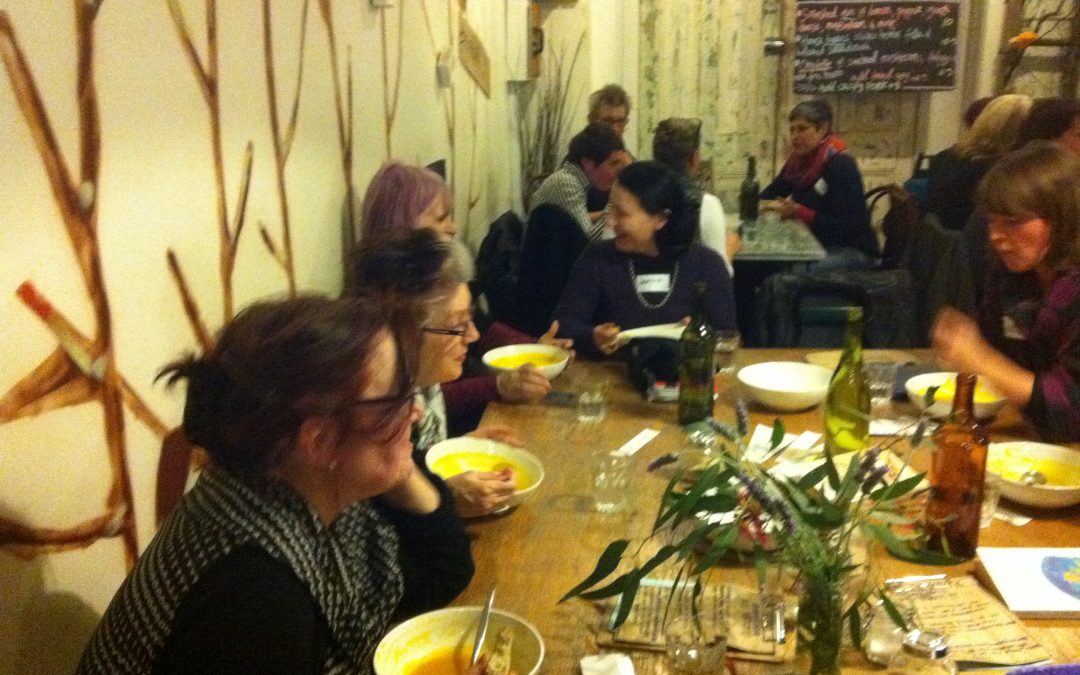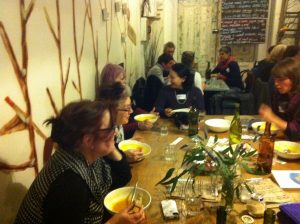Café formats can bring strangers together for facilitated conversations and put them at ease. They can stimulate lively, informal discussion and bring out all sorts of views, and when well done are deliberative in nature. Such cafes have been used extensively in social and community engagements in the last 25 years. They may be small or larger scale groupings and events.
The recent death of the founder of prominent not-for-profit Death Café makes this theme poignant and meaningful to me. As the convenor of Death Café Melbourne I’ve put on a handful of Cafés, at Kinfok Café, and in other public spaces. We had a Solstice Death Café only last month at the City of Melbourne’s lovely Kathleen Syme Library and Community Centre.
Jon Underwood built Death Café into a fabulous worldwide social franchise. It all began as a café with tea and cakes in his home in north London. He strongly believed that there were people like him who wanted to talk freely about death. There have now been over 4,000 Death Cafés worldwide. There is no doubt that the movement will live on.
I’d like to revisit the Café style processes, and refresh perspective on a tried and true, stock staple format for public conversation. What is it about this kind of process that makes it useful for dialogue and discussion? How do we hold the best café style events that are deliberative in intent?
Strangers getting together for important conversations.
People who have never met a facilitator in their life, who are at home with their families or friends, may see a proposal to get together for a chat with strangers as too much of an ask. Yet those who work in the field of facilitation, community engagement, advocacy and education know how important it is to open up discussions between people who don’t share the same views, who aren’t friends or colleagues, but come from different worlds.
These are the reasons why: views are more diverse and representative of the community as a whole; people are more likely to consider the views of others’, perhaps for the first time; conversation is more dynamic and interesting for participants hearing new perspectives.
At the heart of gaining valuable perspectives from discussion lies one vital quality. Strangers need to feel comfortable to open up and say what’s important to them. This sparked the advent of both the World Café and Death Café approaches.
Engagement professionals and the café format
Most engagement professionals value the approach for all the reasons I’ve mentioned. World café formats are seen as a good alternative to the monolithic, old-school style of public meeting, where only a few ardent or determined voices are heard.
Further, there’s great value when working within time constraints in being able to bring out diverse views in a short space of time. Thus World Café is often thought of as a form of speed dating.
Principles
Jon Underwood of Death Café had the insight when he began Death Café that the social convention of sharing food must be part of the picture. He wrote into the definition of Death Café that there should be tea and cake. Very English!
World Café also has a page defining what it is, and has design principles, which give meaning and structure to the process. At times, when observing or being part of World Cafés there’s been a dull sense that everyone’s been thrown together without enough clarity about what they’re there to do. I’ve wondered if the principles could have been revisited.
In fact the word café is more important than people give credit. For instance, World Café’s second principle is to create a hospitable space. Cafés suggest the social world of food drink and table settings. Here’s a great description of the process and atmosphere of a Happiness Café by Lyn Carson with wine glasses on the table, waiters, and linen table cloths.
Café experiences
My first time running a café was as an activist. At the Café for a Nuclear Free Pacific, the red-checked tablecloths on the front lawn of the French Embassy in Canberra shone out. The French patisseries in Canberra were generous. The croissants were ready and the coffee smelt great. People talked on the subject of what they appreciated about French culture, and their concerns about atomic testing. The embassy staff ventured out to investigate. The event received world attention when it was written up in Le Monde.
Learning: well executed cafés on well chosen questions about contested topics can be inspiring and are not confrontative.
The topic of Death Café makes them quite edgy even for participants who really want to have the experience. This makes guidelines very important. Nobody is there as a professional or as someone wanting to promote what they’re familiar with. All participants are simply people who will face death.
Tea and cake helps everyone get together through offering and taking food, holding cups, sipping and enjoying what’s on offer.
Learning: everyone can be on a level at a café.
I’ve learned a lot about having a quality World Café through being a facilitator and participant. I’m glad that I’ve had both views.
What are we trying to achieve and how will it happen? Many who come to the table haven’t had previous experiences of facilitated events or public discussion and find themselves in a completely new environment.
Learning: in some of these situations it would have helped to have the essence of the process in writing on the table. Similarly the idea of having a red card to attract the attention of the facilitators would have helped for tables that were extra confused.
More lessons learned
This post has been an opportunity for me to go back and look at cafe basics afresh. The lessons learned about the method from an international organization training on World Cafés are:
- The question should be very clear to participants
- The method should be explained thoroughly, possibly with a handout
We want to have confidence that the dialogue that emerges from a Café is the best quality dialogue possible. To achieve this, we need to make people comfortable. We can’t underestimate the importance of creating a social setting that enables this.
Finally Café conversations take some time, and it’s unfair to participants to expect them to come out with considered views when there is a rush to keep moving. The World Café is not the same as speed dating.


